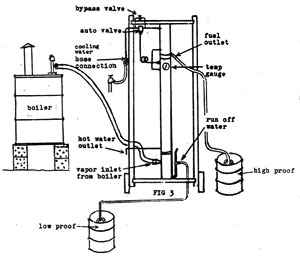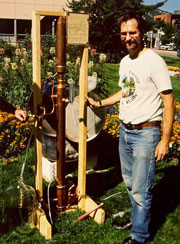
Make Your Own Fuel




The distillation column is separate from the boiler, and the coils are inside the still.





Making Moonshine Legally

Here I am in Boulder, Colorado, turning Boulder Beer into 180 proof, high-octane fuel.
In back of the 5 foot tall distillation column is a 50 gallon drum sitting on my homemade boiler made from a discarded water heater. A black hose brings the hot steam into the bottom section of the still, while the cooled 180-proof pure grain alcohol drains out the clear tubing into a 5-gallon glass bottle.
This was a legal public demonstration of home distillation at a renewable energy fair in the Boulder, Colorado city park. I have a BAFT permit attached at the top right corner of the still's supporting frame.











